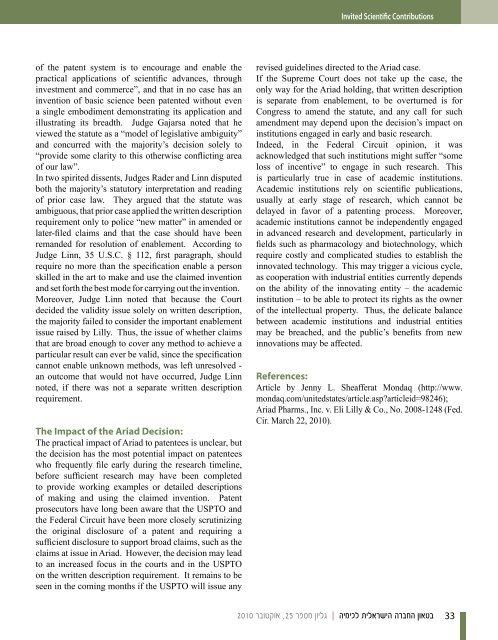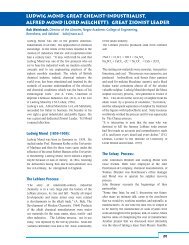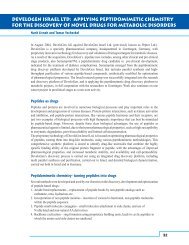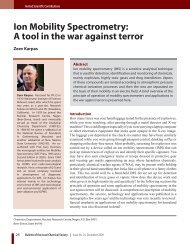CHEMISTRY IN ISRAEL - Israel Chemical Society
CHEMISTRY IN ISRAEL - Israel Chemical Society
CHEMISTRY IN ISRAEL - Israel Chemical Society
You also want an ePaper? Increase the reach of your titles
YUMPU automatically turns print PDFs into web optimized ePapers that Google loves.
of the patent system is to encourage and enable the<br />
practical applications of scientific advances, through<br />
investment and commerce”, and that in no case has an<br />
invention of basic science been patented without even<br />
a single embodiment demonstrating its application and<br />
illustrating its breadth. Judge Gajarsa noted that he<br />
viewed the statute as a “model of legislative ambiguity”<br />
and concurred with the majority’s decision solely to<br />
“provide some clarity to this otherwise conflicting area<br />
of our law”.<br />
In two spirited dissents, Judges Rader and Linn disputed<br />
both the majority’s statutory interpretation and reading<br />
of prior case law. They argued that the statute was<br />
ambiguous, that prior case applied the written description<br />
requirement only to police “new matter” in amended or<br />
later-filed claims and that the case should have been<br />
remanded for resolution of enablement. According to<br />
Judge Linn, 35 U.S.C. § 112, first paragraph, should<br />
require no more than the specification enable a person<br />
skilled in the art to make and use the claimed invention<br />
and set forth the best mode for carrying out the invention.<br />
Moreover, Judge Linn noted that because the Court<br />
decided the validity issue solely on written description,<br />
the majority failed to consider the important enablement<br />
issue raised by Lilly. Thus, the issue of whether claims<br />
that are broad enough to cover any method to achieve a<br />
particular result can ever be valid, since the specification<br />
cannot enable unknown methods, was left unresolved -<br />
an outcome that would not have occurred, Judge Linn<br />
noted, if there was not a separate written description<br />
requirement.<br />
The Impact of the Ariad Decision:<br />
The practical impact of Ariad to patentees is unclear, but<br />
the decision has the most potential impact on patentees<br />
who frequently file early during the research timeline,<br />
before sufficient research may have been completed<br />
to provide working examples or detailed descriptions<br />
of making and using the claimed invention. Patent<br />
prosecutors have long been aware that the USPTO and<br />
the Federal Circuit have been more closely scrutinizing<br />
the original disclosure of a patent and requiring a<br />
sufficient disclosure to support broad claims, such as the<br />
claims at issue in Ariad. However, the decision may lead<br />
to an increased focus in the courts and in the USPTO<br />
on the written description requirement. It remains to be<br />
seen in the coming months if the USPTO will issue any<br />
Invited Scientific Contributions<br />
revised guidelines directed to the Ariad case.<br />
If the Supreme Court does not take up the case, the<br />
only way for the Ariad holding, that written description<br />
is separate from enablement, to be overturned is for<br />
Congress to amend the statute, and any call for such<br />
amendment may depend upon the decision’s impact on<br />
institutions engaged in early and basic research.<br />
Indeed, in the Federal Circuit opinion, it was<br />
acknowledged that such institutions might suffer “some<br />
loss of incentive” to engage in such research. This<br />
is particularly true in case of academic institutions.<br />
Academic institutions rely on scientific publications,<br />
usually at early stage of research, which cannot be<br />
delayed in favor of a patenting process. Moreover,<br />
academic institutions cannot be independently engaged<br />
in advanced research and development, particularly in<br />
fields such as pharmacology and biotechnology, which<br />
require costly and complicated studies to establish the<br />
innovated technology. This may trigger a vicious cycle,<br />
as cooperation with industrial entities currently depends<br />
on the ability of the innovating entity – the academic<br />
institution – to be able to protect its rights as the owner<br />
of the intellectual property. Thus, the delicate balance<br />
between academic institutions and industrial entities<br />
may be breached, and the public’s benefits from new<br />
innovations may be affected.<br />
References:<br />
Article by Jenny L. Sheafferat Mondaq (http://www.<br />
mondaq.com/unitedstates/article.asp?articleid=98246);<br />
Ariad Pharms., Inc. v. Eli Lilly & Co., No. 2008-1248 (Fed.<br />
Cir. March 22, 2010).<br />
2010 רבוטקוא ,25 רפסמ ןוילג | הימיכל תילארשיה הרבחה ןואטב<br />
33






